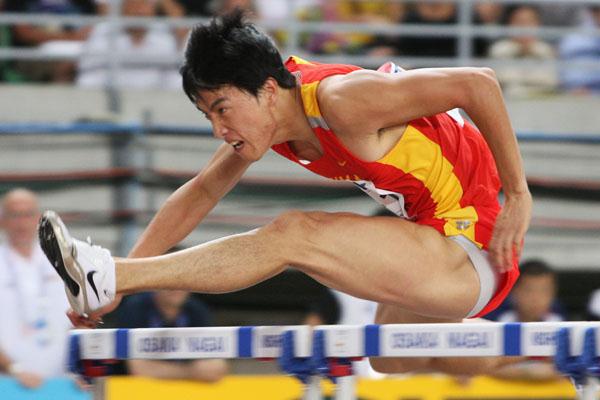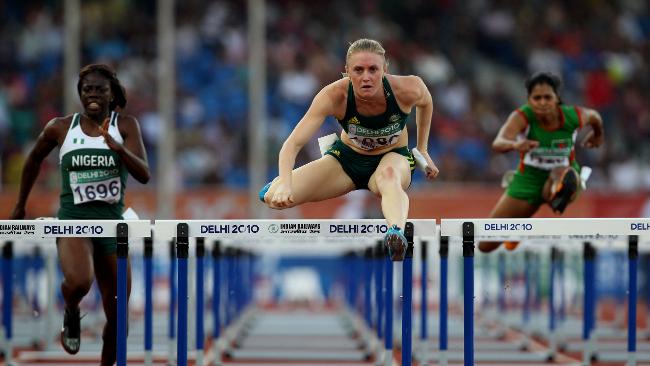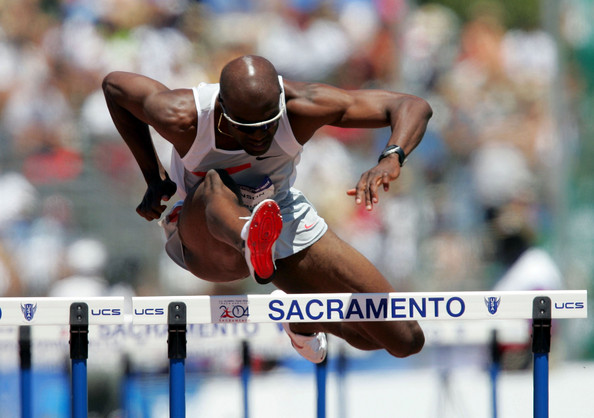Timing on Top
In last month’s issue we focused on the timing aspect of hurdling as it applied to take-off. In this month’s issue we’ll focus on the same topic as it applies to positioning on top of the hurdle. Keep in mind, as you read, that if the timing is off at take-off, it can’t be corrected once you leave the ground. So this month’s article is an extension of last month’s. If you haven’t read that one yet, you’ll want to go ahead and read that one first prior to reading this one.
[am4show not_have=’g5;’]
[/am4show][am4guest]
[/am4guest][am4show have=’g5;’]
Lead Leg:
During take-off, the lead leg emphasis is on driving the knee toward the crossbar. Once you leave the ground, the emphasis shifts to extending the foot toward the crossbar. The lead leg should reach full extension prior to the foot reaching the crossbar. That way, descent can begin as soon as the foot of the lead leg passes the bar. In addition, it’s very important to note that the knee of the lead leg should never lock. Even at full extension, the knee should remain slightly bent (ever so slightly when clearing the men’s 42-inch barriers). A locked-knee lead leg is the most common cause of too much time being spent in the air. Once that knee locks, the hurdler will sail. And even though it sounds poetic to float or “glide” over the hurdles, it’s actually the last thing you want to do. What you want to do is get back on the ground so you can keep running. Another important thing to remember is to keep the ankle flexed so that the toe is pointing to the sky. If you point the toe at the crossbar, you increase the chances of hitting the hurdle with your foot.
Trail Leg:
During take-off, the main function of the trail leg is to push off with as much force as possible so that you are propelled up and over the barrier. Immediately after taking off, the trail leg raises into position. Two things happen at once: The knee raises, and the groin opens. The higher the hurdle, the more the groin needs to open. The key to being able to sprint off the hurdle lies in raising the knee, since that is what is emphasized in the regular sprinting action, when there are no hurdles in the way. A lot of female hurdlers, as well as many taller male hurdlers, open the groin more than they need to. The assumption is that not opening the groin enough will lead to much smashing and crashing. But the truth is, as long as the ankle stays flexed and the toe is not pointing down, you can open the groin minimally and still clear hurdles cleanly as long as you are raising the knee. In regards to timing, this motion of raising the knee/opening the groin occurs along with the extension of the lead leg. The key is to get the knee of the trail leg up, ideally higher than the crossbar, so that when it’s time to bring it to the front, no more raising is needed; you can just run off the hurdle.
Lead Arm:
During take-off, the lead arm rises upward, beside the forehead, or even lower if possible. Its next motion is to extend forward, similarly to the lead leg, and in perfect synchronization with the lead leg. However, the lead arm motion should be tighter. The old-school style of reaching for the toe is a bit much, and will definitely cause a pause. Just like the knee of the lead leg shouldn’t lock, the elbow of the lead arm shouldn’t lock. It shouldn’t straighten all the way, but remain slightly bent. For smaller hurdlers, if the trail leg needs to open more widely at the groin in order to ensure clean clearance, the elbow of the lead arm will need to accommodate the leg by opening outward to give the trail leg room to come through. So to summarize, on top of the hurdle, the lead leg extends, the trail leg raises/opens, and the lead arm extends/opens.
Trail Arm:
The trail arm stays where it is. During take-off, you put the hand on the back pocket, with the elbow bent. On top of the hurdle, it should stay in this position.
Lean:
In terms of lean, nothing changes from what occurred during take-off, when the chest pushed down over the thigh of the lead leg. The key on top of the hurdle is to hold the lean, not to come out of the lean too soon. The lean helps to keep your momentum moving forward, and it helps to prevent floating. Hurdlers who come out of their lean too soon are prone to grabbing hurdles with the lead leg of the hamstring during descent, and of hitting hurdles with the foot or ankle of the trail leg.
Hips:
As with the lean, there’s no change, but just a continuation. During take-off, the hips pushed forward, and now that you’re in the air, they continue to push forward. The lean and the forward push with the hips function together. If the hips rise, you rise. If you rise, you float. If the lean isn’t deep enough, the hips have to twist. There should be no twisting in the hips, no imbalances in the hips. For some smaller hurdlers (and some power hurdlers tend to do this as well), it may be necessary to tilt the hips slightly so that the upper body weight is shifted over the lead leg. Roger Kingdom and David Oliver are two hurdlers who have had a lot of success employing this technique, which I also refer as the shoulder-lean style, since the shoulders tilt with the hips. But keep in mind that “tilt” is not the same as “twist.” When you tilt the hips, they are both still facing the front, and your momentum is still moving forward. When the hips twist, the momentum is moving left to right (or vice versa), causing the arms to swing laterally as the body attempts to correct itself.
All Together Now:
So to summarize, on top of the hurdle, all of the following things happen at once:
- The lead leg extends but the knee doesn’t lock.
- The trail leg knee raises and the trail leg groin opens.
- The lead arm extends but the elbow doesn’t lock.
- The trail arm stays bent, with the hand at the back pocket.
- The lean from the waist is maintained.
- The forward thrust of the hips continues.
Also, not to be redundant, but remember that last month’s article is the key to this one making sense. If your timing is off when your foot leaves the ground, it will be off throughout hurdle clearance.
[/am4show]





